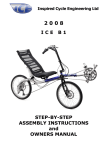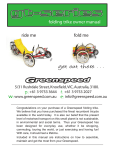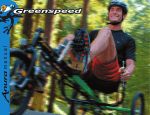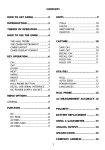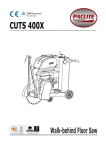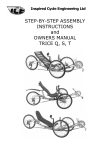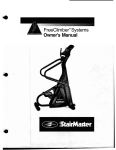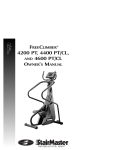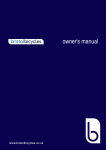Download ICE TRIKES OWNERS MANUAL
Transcript
Inspired Cycle Engineering Ltd ICE TRIKES OWNERS MANUAL Contents: Page: 1. Introduction ........ 1 2. Assembly ........... 1 3. Initial Test Ride ... 11 4. Adjusting ........... 12 5. Riding ............... 15 6. Maintenance ........ 17 7. Accessories ........ 18 8. Contacts ............ 21 1. Introduction. This manual has been written to help you set up and use your trike. We hope you enjoy owning and riding it as much as we like making these great machines. We have included some Tips, which we have learned the hard way. They are well worth taking special note of. Chris, Neil and the ICE team 2. Assembly Assembly tools required: 2mm Hex Key 3mm Hex Key 4mm (ball ended is better) Hex Key 5mm Hex Key 6mm Hex Key 10mm wrench 19mm box wrench 19mm wrench Chain link remover Sharp knife Small flat screwdriver TIP - It is best if you can work on a bench or a table at waist height to avoid too much bending down. If you have to work on the ground put down some newspaper to avoid the chain, which is protected by grease, from picking up dirt. Your trike has been assembled at our works and then taken apart and wrapped for safe and economic shipment. First of all, open the box, unwrap and lay out the pieces. 2.1 Fit and set the handlebars to an approximate position. Slacken off the two clamps, insert the handlebars and adjust to an upright position then lightly tighten at this stage. 2.2 Fit front wheels Identify the left hand and right hand wheels which are labelled on coloured tape in the spokes. Locate the front wheel 12mm axle bolts and 12mm nylock nuts. Slide an axle bolt through the hub from the outside of the wheel (the side with the five webs on the hub flange), then fit the small brake plate spacer over the axle with the small shoulder on the spacer against the bearing in the hub. Slide on the large black brake plate. Now slide the bolt with the complete wheel assembly through the kingpost, locating the single hole in the black brake plate onto the 6mm diameter pin which is part of the kingpost steering arm. 2 Tip – make sure the brake plate is located on the pin as this stops the plate rotating and so makes the brake work. With everything located, add the 12mm spring washer and M12 nylock nut and tighten onto the bolt which is protruding on the inside of the kingpost. A 19mm box wrench and 19mm wrench is the best way to tighten the front wheels. Repeat the fitting procedure for the other wheel. 2.3 Connecting the front brakes. Locate the brake cable adjusting piece into the lower slot in the brake plate and then squeeze the brake arm on the brake plate to locate the brake cable clamping barrel into the brake arm. The brake on that side should now work and you can apply the parking brake by squeezing the brake lever and pushing in the button on the side of the lever. 2.4 Fitting the rear section to the cruciform. Slide the rear section into the cruciform. Evenly tighten the two frame bolts, until the bolts just bite. Align the rear section by eye to make it vertical (stand back a few feet to get a better view). Tighten the two bolts by ¼ turn alternately until the rear section is just clamped enough to prevent it moving around (you will need to adjust this later). 3 2.5 Fit the seat to the lowest position Place the seat on to the trike and see if it lines up with the two mounting cups. Get the seat to fit by sliding the rear frame triangle in or out. The 3 position upper seat mount should be set in the lowest position during this adjustment. Hold the seat on with 4 plastic clips (which are already attached to the seat) and tighten. Check to see if the rear section is upright and then tighten the two rear section main clamp bolts evenly and tightly. 2.6 Fit the front boom to an approximate position. Fit the front boom into the frame taking care not to damage the plastic shim located inside the front of the main frame. Position to approximately a hands span from front mech post to main cruciform end. 4 2.7 Fit pedals (your own if not ordered from us) – the right hand pedal and thread tighten in the normal direction, the left-hand pedal has a left hand thread. 2.8 Set handlebars Sit on and adjust the bars to a position that feels comfortable. Check width clearance between hands and wheels, check clearance between brake levers and frame full lock. Tighten handlebar clamp bolts. 2.9 Set front boom Set the leg length by sitting on and placing your heel on the pedal and adjusting the boom so that your leg is almost straight when the pedal is at its furthest from you. Set the front boom upright (by eye) then tighten the 2 clamp bolts. 2.10 Connect the front changer Thread the front gear cable outer casing through the guide on the side of the frame and up towards the end of the front boom. Thread the inner wire through the cable outer and then through the loose cable guide tube (Chrome noodle). Pass the cable guide up through the hole in the front boom check it is seated correctly and then pull through any slack cable and clamp the inner wire at the front changer. TIP – make sure the left hand shifter is set to the “1” position in the indicator window (smallest gear setting) and the cable and outer casing are located properly in the cable stops. TIP - Do not trim any cables until you are happy with the various settings of front boom and gears. 2.11 Connect the rear changer Fit the short length of gear outer casing into the rear changer and around to the cable stop on the right hand frame chain stay. Thread the inner wire cable through the outer casing. Check the cable is located correctly in the cable guide and then connect and clamp the cable at the rear changer whilst gently pulling through any slack in the system. TIP – make sure the right hand shifter is set to the “8” position in the indicator window (smallest sprocket setting) and the cable and outer casing are located properly. 5 2.12 Check the chain tube lengths Mount the chain tube assembly and pulley onto the frame and check for clearance between the tubes and the front chainset and between the lower tube and the rear changer. If the top chain tube at the front is too long, shorten by cutting the tube at the front end to the required length with a sharp knife. If the lower front tube is too long, adjust the front position of the tube by loosening the tube clamp at the pulley and sliding the lower tube rearward to the required position at the front and re-clamp the tube. Check that the rear changer can pivot forwards fully and cannot hit the end of the lower chain tube. Cut any excess plastic tube from the rear end of the lower tube. 6 2.13 Fit the chain Remove pulley and chain tube assembly from the trike. Put the R pin supplied (or a bobby pin) through one end of the two chains supplied. Hold the assembly vertical and drop a chain down each tube (around the pulley and down the other tube) with the R pins preventing the chains from dropping right through. Add two more R pins to the bottom ends of the chains. Refit the chain tube set and pulley to the trike making sure the tab on the frame is engaged in the pulley plate. Also make sure the Pulley clamping bolt is tight. 7 Twist the right hand rear changer to the “9” so that the rear changer lines up with the smallest rear sprocket. Twist the left hand front changer to the “1” position so that the front changer lines up with the smallest front chainring. Thread the bottom chain up through the derailleur and over the cassette. TIP - make sure the chain is correctly routed through the rear changer cage and goes the correct side of the tab on the changer between the two jockey wheels. Connect to the top chain using the quick connect links supplied. Remove the safety pin in the top and bottom chain at the rear of the trike. Now at the front of the trike, pull the top chain through the top chain tube. Pass the chain through the front changer cage, around the small chain ring and then connect to the lower return chain at the front using the quick connect link. Now set the chain to length by adding or removing a section of chain between the rear changer and the lower chain tube with a chain rivet tool as below. Find one of the connecting links between the rear derailleur and the lower chain tube. Open the link and then work out how much chain to remove. Use an R pin to help stop the chain going back up the chain tube. 8 Make sure you leave enough chain so that it can run from largest chain ring to largest cassette sprocket. Leave just enough slack so that the rear changer jockey wheels are pointing forward but so that they can still move up a fraction. Then check that there is not too much slack when using the smallest chain ring and smallest cassette sprocket. TIP – get an extra pair of hands to help with this. Make sure that any links you alter with the chain link remover are not stiff on the rivets. If in doubt, remove fewer links than you think as removing links is easier than riveting links back in. Use the quick disconnect link to open the chain and then punch out links and quick connect back together. The chain comes with spare joining links so keep these handy for possible future use. 9 2.14 Check the gear shifting Check the rear gears are shifting correctly. Raise the rear wheel off the ground by getting a helper to hold it up or standing an object under the left side dropout so that the pedals can be turned making the chain turn the rear wheel. Gently twist the right hand shifter up through the gears one click at a time whilst turning the pedals. Take care on the rear cassette that the chain does not jump between the largest sprocket and the spokes. This is prevented by one of the two small limit screws on the rear changer which is factory set but can be adjusted if required. Set the left front shifter to the “1” position and the right rear shifter to the “9” whilst turning the pedals then check that there is no excessive slack in the gear cables. Slack must be removed by unclamping, pulling through and re-clamping the gear cables. Check the rear changer indexing by turning the right hand (rear) shifter 1 click to the “8” position whilst turning the pedals and checking that the rear changer has shifted the chain to the second from smallest sprocket. Adjust shifting by carefully turning the cable adjuster at the back of the trike on the rear changer until the chain runs smoothly on the second from smallest sprocket. Now check for smooth changing up through the range. Make any minor adjustments by turning the cable adjuster. Check the front gears are shifting correctly. Adjust the cage limit screws if required. 2.15 Check the brakes Squeeze the brake levers hard and check that the front brakes appear to be operating correctly. 2.16 Fit the Flag Place the flag in the flag holder hole in the left or right side at the top of the seat frame. 10 2.17 Check nuts and bolts Generally check all nuts and bolts to make sure everything is tight. 3.0 INITIAL TEST RIDE CAUTION: If your feet fall from the pedals when you are riding then they could be dragged under the cross axle of the trike. Therefore the trike should only be ridden with your feet securely attached to the pedals, either with special shoes and pedals which you clip into or toe clips and straps. You will not need to put your feet down until you want to get off so being clipped on is comfortable and lets your legs relax when you are not pedalling. Getting on and off the trike. Stand in front of the cross axle with one foot on either side of the front boom. Now bend down and reach back to hold the side of the seat to help lower yourself as you sit. Try not to push or pull on the handle bars as you get on and off. Start on a flat piece of road or drive preferably away from traffic. The front brakes are independent so the left brake operates the left front wheel and the right brake operates the right wheel. Sit on, clip in and make sure you know where the brakes are and that they stop you moving. Before you have ridden more than a few yards check the front brakes. MAKE SURE YOU CAN STOP! Steering is very easy and natural and you will soon become unaware of the movements required. Gear changing. As with any derailleur system you can only change gear when you are pedalling and moving forward. It is easier to change if you are not putting a lot of force on the pedals, particularly when changing from a high to a low gear. The rear changer is operated by the right changer, and the front using the left changer. You should not try to change into the lowest gear (largest rear sprocket) unless you are on the middle or lowest (smallest) chain wheel, because the chain will put strain on the rear changer. TIP - Try to get into the habit of not crossing over the gears at the extremes – don’t run on the biggest chain ring and the biggest rear sprocket or the smallest chain ring and the smallest rear sprocket. This will help prolong the life of the transmission. Also try to anticipate hills and change to a lower (easier) gear before you get onto the steep part of the hill hence avoiding changing gear under pressure. 11 4.0 ADJUSTING Fine-tuning for leg length, seat angle, handle bar width / angle, brake lever reach, tyre pressure etc are all well worth taking time to set to your personal preference. TIP - Experiment but always go for a reasonable (a mile or two) test ride to decide if an adjustment is right for you. 4.1 Leg length A small adjustment can be quite noticeable, just like adjusting the saddle on a conventional bike. • Change gear to the smallest chain ring. • Unclamp the front shifter cable. • Undo the two clamp bolts under the front boom (very loose). • Slide the front boom in or out by twisting and pulling or pushing TIP – It is easier to move the boom if you get a helper to sit on the trike with both front brakes on. • Check the boom is vertical by eye. • Tighten the two clamp bolts under the front boom. • Re clamp the front shifter cable TIP – make sure the left hand shifter is set pointing to the “1” position (smallest gear setting) and the cable and outer are located properly and the slack is removed from the cable when you clamp it. • If you have moved the boom by more than approximately 5mm you will need to check that you have the correct chain length (see Chain length adjustment - section 4.3). 4.2 Seat Angle Adjustment The seat has 3 positions of adjustment • Loosen and remove the long bolt running through the upper seat adjuster. • If you want to make the seat more reclined set it to the holes closest to the seat location cup. Refit the bolt and tighten the seat mount making sure the rack mounting rods are also in place. 12 4.3 Chain Length You may need to adjust the chain length after changes to the front boom length, or wear in the chain after a significant amount of use. TIP - You can cause excessive wear or even complete failure of the rear changer if you increase the length of the front boom without checking to see if the chain is long enough. • Change gear so that the chain is running on the smallest chain ring at the front and the smallest sprocket at the rear. • The chain will now be at its slackest and you will see that the rear changer cage has sprung back and up to take up the slack. • Check to see that the chain now runs as per this picture: • Add or remove links until the chain tension looks like the picture. TIP- split the chain between the rear changer and the return chain tube. Put R pins through the chain to prevent it from accidentally sliding up inside the black return tube when the chain is split. TIP make sure you have not twisted the chain through 180 degrees before joining it back together. TIP - make absolutely sure that any chain links which you rivet back in are not stiff - this can cause some very odd (and not obvious) problems with the chain running freely through the chain tubes. • Finally, change gear so that the chain runs on the largest front chain ring and the largest rear sprocket and check to see if there is still some travel left in the rear changer as per this picture: 13 4.4 Brakes The front brakes are operated independently by each main brake lever. The left lever operates the left brake , the right lever operates the right brake. • Test the brakes whilst riding slowly to check that both levers feel the same and that they do not touch the handle bar grips when squeezed tightly. • The parking brakes are applied by pressing in the small buttons on the side of the levers whilst squeezing the brakes on. • The brake cable tension can be adjusted either on the threaded barrels on the brake levers or on the adjusters located on the brake plates. TIP – periodic removal and greasing of the brake cables helps increase their life and gives smoother operating brakes. 4.5 Gears Refer to the separate gear manufacturer instructions as supplied with your trike and see section 2.14. 4.6 Mesh Seat Cover When new both the seat cover and the straps stretch a little, and in the first few weeks of use you may need to re-tension the seat by tightening up the straps. In time it will settle down. For maximum comfort you may need to tighten the cover more in some places than in others. Do not over tighten any one strap as they cannot be slackened other than cutting the strap. 14 5.0 RIDING CAUTION (again): If your feet fall from the pedals when you are riding then they could be dragged under the cross axle of the trike. Therefore the trike should only be ridden with your feet securely attached to the pedals, either with special shoes and pedals which you clip into or toe clips and straps. You will not need to put your feet down until you want to get off so being clipped on is comfortable and lets your legs relax when you are not pedalling. 5.1 Getting on and off the trike. Stand in front of the cross axle with one foot on either side of the front boom. Now bend down and reach back to hold the side of the seat to help lower yourself as you sit. Try not to push or pull on the handle bars as you get on and off. 5.2 Tyre Pressures These should be about 70-80 psi all round for normal use though they can be varied within the maximum and minimum ratings as shown on the tyre side walls. Softer tyres will give a more comfortable ride on bumpy roads. Very high pressures do not necessarily mean better speed…experiment. 5.3 Stopping in a low gear As with an ordinary bicycle it is best to get into the habit of finishing your journey in an easy gear so that you can pull away easily when you start again. 5.4 Relax Whilst riding sit back and relax. DO NOT PULL ON THE HANDLEBARS, just hold them lightly. The trike will tend to steer itself in a straight line depending on the road surface and camber. TIP – The steering of the trike runs on ball bearings so it is very smooth and requires minimal effort to steer. The gear cables run forward and backwards and the spring effect in these cables tend to make the trike slowly turn to the left if you let go of the handlebars completely. This is normal and we do not recommend riding without holding at least one of the handle bars or you will not have proper control of the trike. 15 5.5 Brakes Normal braking should be done with both levers together and evenly for excellent stopping power. 5.6 Hill climbing. A recumbent trike or bike tends not to climb a hill as fast as a lightweight bike whose rider can get off the saddle to use his/her weight to get extra effort. It will climb in comfort at a lower speed and in a lower gear. You should never need to get off and push, even when carrying a heavy load. 5.7 Descending a hill. Caution, Take care on your first down hill rides until you gain experience. You will find you can go fast and with confidence once you are used to the way the machine handles. Because there is less air drag in the recumbent position you will go faster than a bike. You have powerful brakes with good stopping power. CAUTION, the brakes are powerful and if they are applied sharply on some of our models with higher seats, you can cause the rear wheel to rise up and the frame can tip so far that the front touches the ground. 5.8 Ground clearance. When going over very rough ground the underside of the frame could touch the ground. If you think there is a chance that the underside of the frame may hit an obstacle, get off first and look under the trike to see how close things are getting. You will quickly learn to recognise terrain that your trike can easily handle. If you do contact the underside of the frame then, it's unlikely any serious damage will be done (other than scratching the paint) but check to make sure everything is OK. 16 6.0 MAINTENANCE TIP - as with any cycle, a small amount of regular care will prolong the life of your trike and its components. The simplest thing you can do is to regularly give a quick drop of oil to all of the moving parts especially after riding in heavy rain. Always keep the chain and chain tubes oiled. 6.1 Adjusting the track. To avoid excessive tyre wear the front wheels must be kept parallel. Tracking only needs to be checked if you suspect damage through an accident, or if unusual wear starts on one or both front wheels. • Use a long ruler or a piece of rod to measure between the inside of the tyres at the front of the tyres, and then at the rear. The distance should be the same, or up to 2mm less at the front. • If the tracking is out of adjustment, loosen the two lock nuts on one track rod and rotate the rod (a small rotation gives a fairly large change in track). TIP - note that the lock nuts at each end of the track rods have left and right handed threads (the left hand threaded nuts have a small notch to identify them). Because there is a left hand thread at one end and a right hand thread at the other you can adjust the track very precisely. Tighten up the lock nuts when the distance is right. 6.2 Lubricating the chain. At regular intervals, and always after riding in wet weather, you should lubricate the chain. 6.3 Lubricating the bearings. Rear wheel, head set and pedal bearings on your trike will need greasing from time to time depending on riding conditions as with any conventional cycle. 6.4 Serial No. The serial number is marked on the under side of the main cross joint. 17 6.5 Recommended Minimum Tools and Spares 6.5.1 Get you home kit • • • • • • • • Tyre levers Spare inner tube Puncture repair kit Mini Pump Small adjustable spanner 3, 4, 5, 6mm Hex Keys Small Phillips screwdriver Spare Chain link 6.5.2 Full Touring Kit - All of the above plus at least these items: • 8mm spanner. • 9mm spanner. • 10mm spanner. • 19mm box spanner. • 19mm spanner. • 8mm Hex Key (for Shimano Cranks). • Chain link extractor tool. • Spare gear cable. • Spare brake cable. 7.0 ICE OPTIONAL ACCESSORIES 7.1 Front Mudguards Front mudguards fit onto the steering pivots and can be quickly removed by one bolt in each unit. • To fit the mudguards, remove the bolt and washer from the top of the steering pivots and then clamp the mudguards directly onto the top of the steering pivot re-using the bolt and washer. TIP – The mudguard clamping bolts do need to be done up tight to prevent the mudguards from pivoting round in use. 18 • To remove a mudguard, loosen and remove the single clamping bolt and washer at the top of the steering pivot on each wheel. • Cover the exposed mounting hole by re-fitting the bolt and washer. 7.2 Computer A computer can be fitted with the aid of an optional mounting kit. The computer bracket clamps onto the bottle bosses on the main frame (just in front of the main cross joint). The sensor is fitted to the kingpost mount and set to line up with the magnet clamped to the spokes. Secure the cable to the frame along the underside of the cross axle using electrical tape. “Handle bar” bag side mount This optional item allows a standard “handle bar” bag to be mounted beside the seat. The mount is clamped around the seat frame cross rail and adjusted to the desired position. 7.3 Lights. Front lights may be fitted to the front changer tube utilising the optional ICE front light mount. Rear lights can be mounted to the rear of the carrier, or on the rear seat stay or seat cross rail. 19 7.4 Extra water bottle mount. An extra water bottle mount can be fitted to the seat frame by using the option ICE bottle cage mount and a bottle cage. 7.5 Neck rest The optional neck rest can be fitted to the frame. The rest is adjustable for height and is designed to suit a wide range. Key rings are included with the trike. Keep an extra one on your bike keys and if someone asks where you got your trike, please give them a keyring which has our tel number and web address on it. Call us if you need more key rings. 20 8.0 Recumbent/Trike forums on the Internet Now that you have your new trike, why not share your experiences with others on some of the internet forums? IHPVA Lists There is a trikes specific mailing list run by the IHPVA (International Human Powered Vehicle Association). The list generates one or more emails daily (in digest mode). You can subscribe to the trikes mailing list at http://www.ihpva.org/mailman/listinfo/trikes The same page will also let you unsubscribe and change your subscription options. Bent Rider Online. The BentRiderOnline website is a valuable source of information. They operate a message board (forum) that is moderated and is free to join. You will need to register before you can post a message, but the forum is available for anyone to read. To register, point your browser to www.bentrideronline.com and click on the 'Message Board' link at the top of the page. On this new page, you will find links to the FAQ (Frequently Asked Questions) and the registration page. Follow the simple instructions and you will be registered to participate in the discussion. There is a Trikes specific forum under Speciality Discussions, and you will find a number of Trice and ICE owners there. Velo Vision Velo Vision is a magazine, published in the UK, covering specialised bikes, cycling as transport and human power. We'd have to agree when they say "It's a quarterly dose of cycle inspiration." To get to the forum, point your browser to http://www.velovision.co.uk/forum/ follow the link to 'VV discussion' To register, click on the 'Log In' link and then follow the link to 'Need a Login? Register Here'. The registration is painless and allows you to post on the forum. This forum is not arranged by subject, but just has a list of the topics presently under discussion. uk.rec.cycling uk.rec.cycling is an unmoderated Usenet group. This is a friendly gathering of enthusiasts who discuss a wide range of subjects, usually related to cycling in the UK. There are a number of recumbent riders and trike owners who are regular contributors to the group. To join the group, you will have to set up a Usenet (News) account with your Internet Service Provider. This is usually free. Your provider will be able to provide you the details of how to configure your email software to access the group. Alternatively, you can access the group through the Google search engine page. Point your browser to http://groups-beta.google.com/group/uk.rec.cycling and read the posts at your leisure. You can post to the group if you follow the Google Groups registration process. 21 Contact ICE You can find us at: Inspired Cycle Engineering Ltd Unit 9b.Spencer Carter Works, Tregoniggie Industrial Estate, FALMOUTH, Cornwall TR11 4SN England Telephone & FAX 01326 378848. (+44-1326-378848 outside UK). or by e-mail [email protected] 29th Sept 2005 22






















